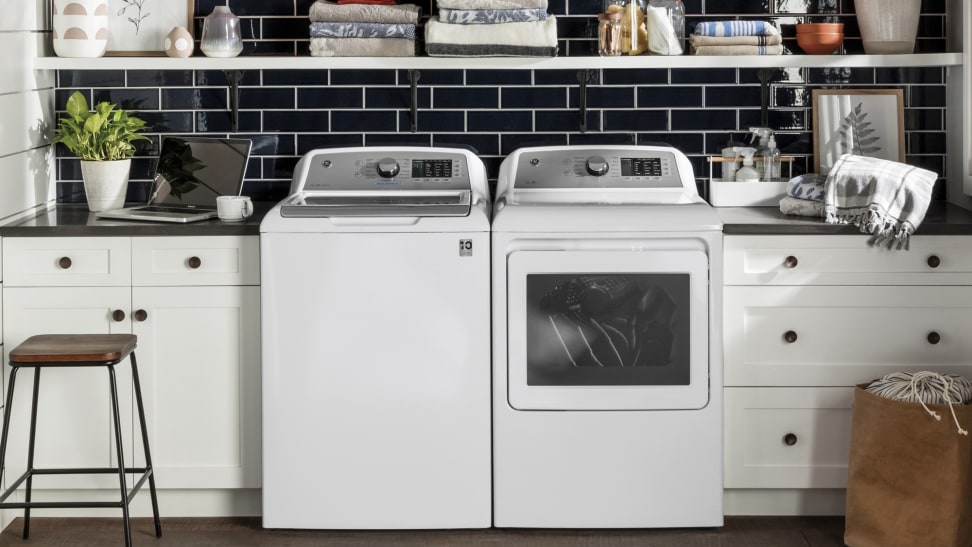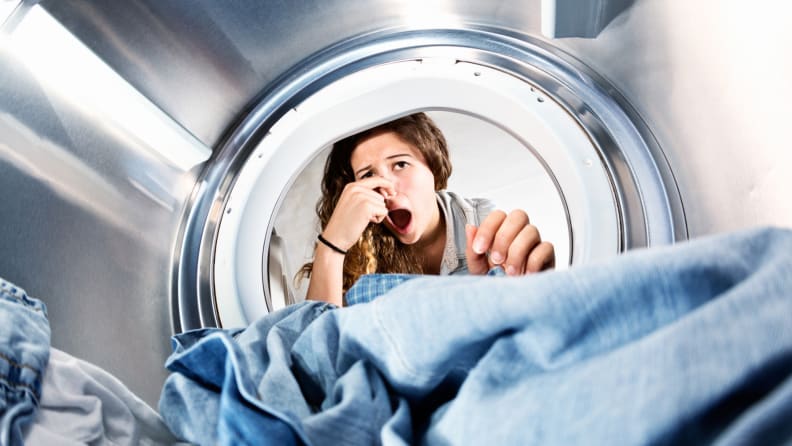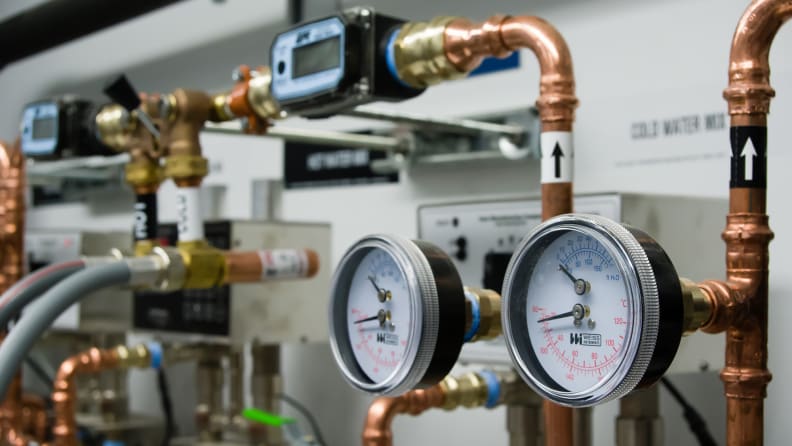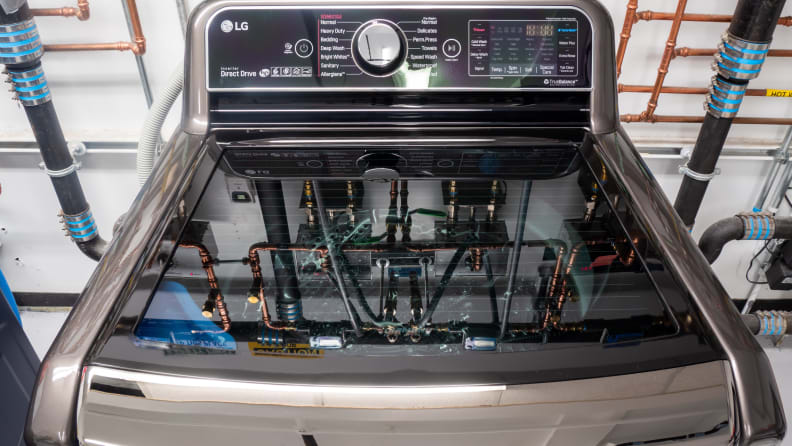Are top-load washers all washed up?
Top-loaders were here first, but front-loaders are coming for 'em
 Credit:
GE
Credit:
GE
Recommendations are independently chosen by Reviewed's editors. Purchases made through the links below may earn us and our publishing partners a commission. Prices were accurate at the time this article was published but may change over time.
Some product wars are legendary. VHS vs. Betamax, Blu-ray vs. HD DVD, iOS vs. Android—debates over tech have divided shoppers, retailers, and even friendships.
Well, the fight has moved on to the laundry room, with Americans holding surprisingly strong opinions on whether front-loading or top-loading washing machines are better at cleaning clothes.
Yes, you read that correctly. Just browse the comment sections of online washer reviews or ask a retailer, and you’ll uncover a great deal of unexpected animosity.
First generation front-loaders had a rocky start in the U.S.

Old front-loaders could develop a smell, due to water getting trapped in and around the gasket they needed for a water-tight seal around the door.
Top-loaders, you’ll hear, are ineffective, water-guzzling relics. Front-loaders, meanwhile, are allegedly overpriced under-performers forced upon the public by naïve do-gooders. So, who's right?
To understand where these divisive opinions originated, we need to look at the storied history of front-loaders in the U.S. In the past, Americans were in love with front-loaders, which first reappeared in the U.S. in 1997 after a long absence. The new, modern machines promised to be more efficient and more effective, and customers clamored for the Maytag Neptune, LG Tromm, and Whirlpool Duet starting in the early 2000s.
Then, in 2009, everything changed. According to sales tracking firm Traqline, in the fourth quarter of that year, about 45% of washers sold in the U.S. were front-loaders. In the years after, however, that figure dropped to just 29.5%. What happened?
It turns out those earliest generations of front-loading washing machines weren’t as reliable or user-friendly as the top-loading machines they aimed to replace, despite commanding significantly higher prices. Some vibrated so badly that they would “walk” across the laundry room floor. Others developed foul odors—a complaint that would take manufacturers all the way to the Supreme Court.
Additionally, consumers didn’t like that they had to bend over to load and unload the front-loading washing machines, hated that they had to pause a cycle to add a garment, and couldn’t understand why they didn’t fill up all the way with water.
Most of these problems were fixed in successive generations—vibration control systems have gotten better, gaskets aren’t developing mildew, and while front-loading washing machines still run on the expensive side, there are many solid machines available for under $800.
However, scorned early adopters aren’t big on second chances, especially the consumers who lived with problematic first-generation front-loaders for years. And, when it has come time for these consumers to replace the first-gen front-loaders, many opted for high-efficiency top-loaders.
Examining the data between top-loaders and front-loaders

Our labs have rigorously tested nearly all of the best-selling front- and top-load washers on the market since 2011.
To determine which type of washer really performs better, we averaged data from our top five top-load and top five front-load washers, pitting the two categories against one another in four metrics: cleaning performance, energy efficiency, water usage, and water retention.
First and foremost, a washing machine has to remove stains. While top-loaders have gotten much better at cleaning, we find that, on average they’re still about 4.6% less effective at their job. The smallest gap was between quick cycles, where front-loaders performed about 2.6% better, and the widest gap was on the delicates cycle, where front-loaders cleaned 6.7% more stains than top-loaders. Front-loaders had the edge on normal and heavy cycles as well, cleaning 4.7% and 4.5% better, respectively.
Overall, front-loaders have a small advantage when it comes to scrubbing out stains—nothing huge, but a margin exists nonetheless.
Contrary to popular belief, using more water doesn’t necessarily get clothes any cleaner. Top-loaders use almost twice as much water than front-loaders: 8,692 gallons per year versus a front-loader's 4,469 gallons.
Things shift back the other way when it comes to electricity. Front-loaders use about 58.6 kwH of electricity per year, where top-loaders only used 33.2 kwH. Although this does seem like a win for top-loaders, there is one other factor that actually puts front-loaders slightly ahead here.
When it comes to spin cycles, front-loaders are the clear winner. While their normal cycles tended to spin out about 5.6% more water than top-loaders, on heavy and quick cycles those numbers jump up to 19.1% and 19.8% respectively. This is important, because evaporating water in your dryer takes significantly more energy than spinning it out, allowing front-loaders to close that energy-usage gap mentioned above (albeit indirectly).
What about cost?

Despite their popularity, top-loaders fall short of front-loaders on most key metrics.
Performance and efficiency aren’t the only concerns. Some users prefer the ergonomics of a top-loader, and the largest front-loading machines won’t fit in all laundry rooms.
That being said, for most consumers, price is probably the biggest sticking point—but even that has equalized over time. The days of needing to pay three times the cost for a front-loader are far behind us, and the highest-end top-loaders run about the same as the highest-end front-loaders: about $1,200. Likewise, midrange models for both styles run in the $800–900 range, with plenty of cheaper options available for both.
Because front-loaders were the first design to get more modernized, it was once true that they'd command a premium price for repairs, since they had more digital components. Modern top-loaders are just as digitized as front-loaders now, though, and just about every model has some kind of touchpad to compliment the cycle-selection dial.
When it comes to resources, the competition is more of a wash. Modern front-loaders actually use about half as much water, but top-loaders use about half as much electricity (though that number shrinks when you account for front-loader's superior spin cycles reducing drying time). Regardless, these differences equate to relatively small numbers in terms of cost to the consumer: Expect savings in one category or another to fall in the $20–30 range over the course of a year.
So, here's the question: Are top-loaders all washed up?
Not at all. Despite the overwhelming data supporting the technical superiority of front-loaders, we’re not surprised that top-loaders are still as popular as they are.
Part of the issue is likely generational. People often feel more comfortable buying a washer that's similar to the one they grew up with, and those who are now in the position to buy a washing machine likely grew up with a top-loader.
Additionally, many likely remember the false start that front-loaders had in the 2000s. Many user reviews made in the past few years will still complain about a front-loader not filling up with water, despite the science being settled: Unless your clothes are caked with mud, using more water will dilute the detergent, leading to a lower quality clean. This is why so many modern top-loaders come equipped with a "deep fill" button or an equivalent that adds more water to the washer's drum.
What's to come next, we can't predict, but unless top-loaders see some significant technological upgrades, the future is in front-loading.
The product experts at Reviewed have all your shopping needs covered. Follow Reviewed on Facebook, Twitter, Instagram, TikTok, or Flipboard for the latest deals, product reviews, and more.
Prices were accurate at the time this article was published but may change over time.




